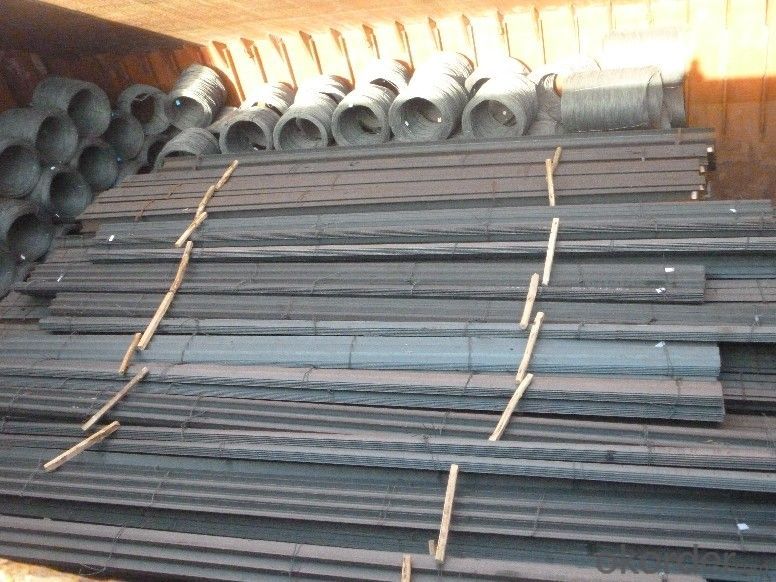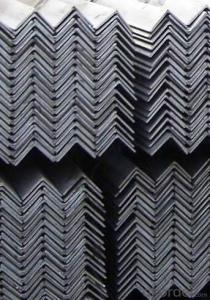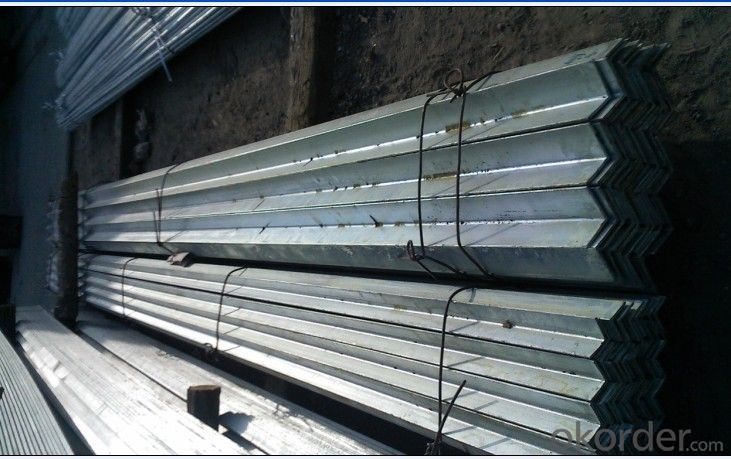GB STANDARD HIGH QUALITY HOT ROLLED ANGLE
- Loading Port:
- Tianjin
- Payment Terms:
- TT OR LC
- Min Order Qty:
- 50 m.t.
- Supply Capability:
- 100000 m.t./month
OKorder Service Pledge
OKorder Financial Service
You Might Also Like
Appearance: Black
Technique: Slitting hot rolled steel coil
Grade: Q235, Q195,A36 SS400 S235jr.St37-2
Standard: AISI,GB,DIN,ASTM,EN,JIS
Length: 6m, 9m, 12m or as your requirement.
Width: 10mm-1010mm
Thickness: 1.5mm-20mm
Business type: big manufacture
Place of origin: Tianjin China (Mainland)
Packaging Details: In bundles for exporting and sea worthy
Delivery Detail: Within 15-35 days after receiving L/C or deposite T/T


General specification as below:
Flat Bar Specification | |||
Width (mm) | Thickness (mm) | Length (m) | Theoretical Weight (kg/m) |
20 | 2.0 | 6/9/12 | 0.31 |
20 | 2.5 | 6/9/12 | 0.39 |
20 | 2.75 | 6/9/12 | 0.43 |
25 | 2.5 | 6/9/12 | 0.49 |
25 | 3.75 | 6/9/12 | 0.74 |
30 | 2.5 | 6/9/12 | 0.59 |
30 | 3.5 | 6/9/12 | 0.82 |
30 | 9.75 | 6/9/12 | 2.30 |
40 | 3.5 | 6/9/12 | 1.10 |
40 | 4.75 | 6/9/12 | 1.50 |
40 | 11.75 | 6/9/12 | 3.69 |
50 | 2.75 | 6/9/12 | 1.08 |
50 | 4.5 | 6/9/12 | 1.77 |
50 | 9.75 | 6/9/12 | 3.83 |
60 | 5.5 | 6/9/12 | 2.60 |
60 | 7.5 | 6/9/12 | 3.53 |
60 | 11.5 | 6/9/12 | 5.42 |
80 | 5.5 | 6/9/12 | 3.45 |
80 | 7.5 | 6/9/12 | 4.71 |
80 | 11.75 | 6/9/12 | 7.38 |
100 | 3.25 | 6/9/12 | 2.55 |
100 | 4.75 | 6/9/12 | 3.73 |
100 | 7.5 | 6/9/12 | 5.89 |
120 | 9.75 | 6/9/12 | 9.18 |
120 | 11.75 | 6/9/12 | 11.07 |
150 | 9.75 | 6/9/12 | 11.48 |
150 | 11.5 | 6/9/12 | 13.54 |
150 | 13.5 | 6/9/12 | 15.90 |
160 | 11.75 | 6/9/12 | 14.76 |
200 | 9.5 | 6/9/12 | 14.92 |
250 | 5.75 | 6/9/12 | 11.28 |
340 | 7.75 | 6/9/12 | 20.68 |
Products Advantages
1. high quality competitive price and Accurate in size
2. high dimensional accuracy
3. Guaranteed raw material
4.high utilization rate of material
5.convenient in construction, saving much time and labor
6. high mechanical strength
Application: Widely used for construction, Ship building, Machinery manufacturing ,steel structure,agriculture and steel grating.
- Q: How do you protect steel angles from moisture?
- There are several measures you can take to protect steel angles from moisture: 1. Applying a protective coating is a highly effective method. By using paint or primer, you create a barrier that prevents direct contact between the steel and moisture, thus avoiding potential corrosion. 2. Another option is galvanization. This involves coating the steel angles with a layer of zinc, which provides excellent protection against moisture. This process creates a sacrificial layer that corrodes before the steel, extending its lifespan. 3. Implementing proper drainage systems is crucial. By installing gutters, downspouts, or using sloping surfaces, you can ensure water does not accumulate around the steel angles, preventing prolonged exposure to moisture. 4. Regular inspection and maintenance are essential. Keep an eye out for signs of moisture buildup, rust, or damage on the steel angles. Take immediate action by cleaning, repairing, or applying additional protective coatings to prevent moisture from seeping in. 5. Consider using moisture-absorbing materials such as desiccants or silica gel packs in the vicinity of steel angles. These materials help reduce humidity levels and prevent moisture buildup. 6. If the steel angles are located in an enclosed space, controlling humidity levels is crucial. Ensure proper ventilation and use dehumidifiers or fans to reduce moisture and prevent condensation on the steel surfaces. By following these preventive measures, you can effectively safeguard steel angles from moisture, increasing their lifespan and preventing corrosion.
- Q: Can steel angles be used as reinforcements in concrete structures?
- Yes, steel angles can be used as reinforcements in concrete structures. Steel angles are commonly used as reinforcement in concrete structures due to their high strength and durability. They are typically placed within the concrete to provide additional support and prevent cracking or failure under heavy loads or stress. Steel angles are versatile and can be easily incorporated into the design of various concrete structures such as beams, columns, walls, and slabs. They are often used in combination with other types of reinforcement like steel bars or mesh to enhance the overall strength and stability of the concrete structure. Steel angles are preferred for their ease of installation, cost-effectiveness, and ability to withstand the harsh environmental conditions typically encountered in construction projects.
- Q: What are the design considerations for using steel angles in construction?
- When considering the use of steel angles in construction, there are several design considerations that need to be taken into account. Firstly, the load-bearing capacity of the steel angles is a crucial factor. The size and thickness of the angle must be carefully chosen to ensure that it can support the anticipated loads and stresses imposed on the structure. This involves considering factors such as the weight of the structure, live loads, wind loads, and seismic forces. Another important consideration is the connection details. Steel angles are typically joined using bolts, welds, or a combination of both. The design of these connections must be carefully engineered to ensure they can transfer the loads effectively between the angles and other structural components, such as beams or columns. The connection details should also be designed to account for potential movement or expansion of the structure to prevent any failure or damage. The design must also take into account the potential for corrosion. Steel angles can corrode over time when exposed to moisture or aggressive environments. Therefore, appropriate protective measures such as coatings or galvanization should be considered to enhance the durability and lifespan of the structure. Additionally, the aesthetics and architectural requirements of the project should be considered. Steel angles can be used not only for their structural properties but also for their visual appeal. The design should take into account the desired appearance, such as the shape, size, and placement of the angles, to ensure they complement the overall design intent of the structure. Lastly, the cost and availability of steel angles should also be considered. The design should optimize the use of steel angles to minimize material waste and fabrication costs. It is important to select standard sizes and shapes that are readily available in the market, as it can reduce lead times and costs associated with custom fabrication. In conclusion, the design considerations for using steel angles in construction include load-bearing capacity, connection details, corrosion protection, aesthetics, and cost. By carefully considering these factors, engineers and architects can ensure that steel angles are effectively integrated into the design, contributing to a safe, durable, and visually pleasing structure.
- Q: What are the different methods for painting steel angles?
- There are various approaches to painting steel angles, depending on the desired outcome and project conditions. Some commonly used methods include: 1. Applying with a brush: This traditional method involves using a paintbrush to directly apply paint onto the steel angle's surface. It offers greater control and precision, especially for smaller or intricate areas. 2. Utilizing spray application: Spray painting is favored for large-scale or industrial projects. It entails using a paint sprayer to evenly distribute paint onto the steel angle. This method is quicker and more efficient than brush application, resulting in a smooth, uniform finish. 3. Employing powder coating: This method involves applying a dry powder to the steel angle and then curing it under heat. The result is a durable and visually appealing finish. Powder coating is known for its resistance to chipping, scratching, and fading, making it ideal for outdoor applications or high-traffic areas. 4. Using electrostatic painting: Electrostatic painting employs an electric charge to attract paint particles to the steel angle. This technique ensures even coverage, reduces overspray, and yields a smooth and long-lasting finish. It is commonly used for large or complex surfaces due to its superior adhesion and coverage. 5. Opting for galvanizing: Galvanizing is a unique method used to protect steel angles from corrosion. It involves coating the steel angle with a layer of zinc through a hot-dip or electroplating process. Galvanized steel angles are highly durable and resistant to rust, making them suitable for outdoor or high-moisture environments. While galvanizing does not provide a specific color or aesthetic finish, the zinc coating can be painted over if desired. When selecting a painting method for steel angles, it is crucial to consider factors such as the desired appearance, durability, environmental conditions, and project specifications. Seeking guidance from a professional or adhering to the manufacturer's recommendations can help ensure the most suitable method is chosen for each unique project.
- Q: Can steel angles be used for ladder rungs?
- Yes, steel angles can be used for ladder rungs. Steel angles are often used in construction and fabrication for their strength and durability. They can provide a solid and secure surface for climbing on ladders. However, it is important to take into consideration the specific requirements and regulations for ladder rungs, such as the dimensions, spacing, and anti-slip properties. These factors ensure the safety and stability of the ladder for users. It is recommended to consult relevant safety guidelines and standards before using steel angles as ladder rungs.
- Q: How do you prevent and address corrosion in steel angles?
- Corrosion prevention and addressing in steel angles can be achieved through several effective measures. Here are some steps you can take: 1. Proper surface preparation: Thoroughly clean the steel angles before applying any protective measures. Remove any dirt, grease, or other contaminants using a suitable solvent or detergent. 2. Protective coatings: Applying a high-quality coating is crucial to prevent corrosion. Options include paints, primers, and specialized corrosion-resistant coatings designed for steel. Ensure the coating is compatible with the environmental conditions the steel angles will be exposed to. 3. Galvanization: Galvanizing steel angles can provide excellent corrosion resistance. This involves applying a layer of zinc to the surface, creating a barrier between the steel and the corrosive elements in the environment. 4. Regular inspection and maintenance: Periodically inspect the steel angles for signs of corrosion, such as rust or pitting. Address any corrosion issues immediately to prevent further damage. This may involve removing the damaged coating, treating the corroded area, and reapplying a protective coating. 5. Cathodic protection: For critical applications or aggressive environments, consider implementing cathodic protection. This technique involves connecting sacrificial anodes or installing impressed current systems to protect the steel angles from corrosion by creating an electrochemical reaction. 6. Environmental control: Limiting exposure to moisture, humidity, and corrosive chemicals can significantly reduce the risk of corrosion. Proper ventilation, dehumidification, and avoiding direct contact with corrosive substances are essential preventive measures. 7. Routine cleaning: Regularly clean the steel angles to remove any accumulated dirt, debris, or corrosive substances, as they can accelerate corrosion. Use gentle cleaning methods and avoid abrasive materials that can damage the protective coating. Remember, preventing and addressing corrosion in steel angles requires a proactive approach. By implementing these measures, you can extend the lifespan of the steel angles and maintain their structural integrity.
- Q: Can steel angles be used in the construction of theatres?
- Yes, steel angles can be used in the construction of theatres. Steel angles are versatile structural components that can provide support and stability to various elements of a theatre, such as stage platforms, lighting rigs, and seating structures. They are commonly used in the construction industry due to their strength, durability, and ability to withstand heavy loads, making them suitable for theatre construction projects.
- Q: Can steel angles be used as handrails?
- Yes, steel angles can be used as handrails. Steel angles provide strength and stability, making them suitable for use as handrails in various settings such as stairs, ramps, balconies, and walkways. They can be welded or bolted securely to provide a reliable grip and support for individuals while navigating these areas.
- Q: Can steel angles be used in marine or underwater applications?
- Yes, steel angles can be used in marine or underwater applications. Steel angles are often used in the construction of various marine structures, such as ships, offshore platforms, and underwater pipelines. The high strength and corrosion resistance of steel make it suitable for withstanding the harsh conditions of the marine environment, including exposure to saltwater and extreme temperatures. Additionally, steel angles can be easily welded or bolted together to form a strong and durable structure, making them an ideal choice for marine and underwater applications.
- Q: What are the different types of connections used for steel angles in residential applications?
- There are several different types of connections used for steel angles in residential applications. Some of the most commonly used ones include: 1. Welded connections: This is the most common type of connection used for steel angles. It involves welding the angle to the adjacent structural members, such as beams or columns. Welded connections provide excellent strength and rigidity, making them ideal for residential applications. 2. Bolted connections: Bolted connections involve using bolts and nuts to secure the steel angle to the adjacent members. This type of connection is often used when the angle needs to be easily removable or adjustable. Bolted connections are less rigid than welded connections but still provide sufficient strength for residential applications. 3. Clip connections: Clip connections are typically used to connect steel angles to wood or other non-steel materials. They involve using clips or brackets that are attached to the angle and then fastened to the adjacent material using screws or nails. Clip connections are commonly used in residential framing applications. 4. Gusset plate connections: Gusset plate connections are used when two steel angles need to be connected at a joint. A gusset plate, which is a flat plate of steel, is welded or bolted to the angles to provide additional support and rigidity. This type of connection is often used in residential roof trusses and other structural applications. 5. Cleat connections: Cleat connections involve using a steel plate, called a cleat, that is bolted or welded to the steel angle and the adjacent member. Cleat connections are commonly used when the angle needs to be attached to a horizontal member, such as a floor or roof joist. These are just a few examples of the different types of connections used for steel angles in residential applications. The choice of connection type will depend on factors such as the structural requirements, ease of installation, and the type of materials being connected.
Send your message to us
GB STANDARD HIGH QUALITY HOT ROLLED ANGLE
- Loading Port:
- Tianjin
- Payment Terms:
- TT OR LC
- Min Order Qty:
- 50 m.t.
- Supply Capability:
- 100000 m.t./month
OKorder Service Pledge
OKorder Financial Service
Similar products
Hot products
Hot Searches
Related keywords




























